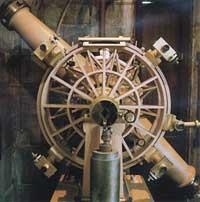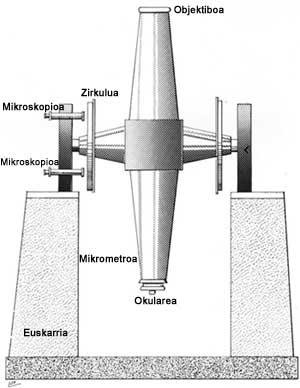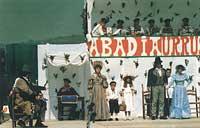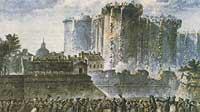Abbadia Observatory
1993/08/01 Telletxea, Martin Iturria: Elhuyar aldizkaria
In 1880 Antoine Abbadia, a passionate astronomer, installed a Meridian lens west of the castle, in a large room prepared for it.

Thanks to this tool he could determine the movement and position of the stars. The circles are divided into centesimal degrees and not sexagesimal, as usual. Mr. Abbadia tried to introduce the decimal division of angle and time, but he did not succeed in it.
In his donation to the Academy of Sciences in 1896, Abbadia stated: “that the Observatory publish and disseminate the catalogue of 500,000 stars”. Aware of the prosperity of the work, he asked that it be carried out by religious who “are outside the headaches of this world”. At the same time, he led a Belgian oratory of the observatory: Father Verschaffel. However, the Council of State rejected the requested clause and Antoine had to modify his donation. However, the Academy of Sciences assured him that his wish would be respected.
Antoine died in 1897 and the Observatory already worked very well. Father Verschaffel, an imaginative astronomer, invented the first chronograph recorder.
It has the merit of training its young people, who handled with great skill the lens meridiana.
The first publications appeared in 1902. They worked until the beginning of the world war, when until then 26 star catalogues were published that gave fame to the Abbadia Observatory in the world of astronomy.
With the entry of the Germans, the works were suspended.
After the war, the Academy decided to repair the Observatory. With the help of the Bordeaux Observatory, the lens was equipped with an impersonal micrometer and modern electronic material.
In 1962 the Observatory resumes and participates in two major programs under the International Astronomical Commission: In the SRJ program, under the direction of the U.S. Navy and P. 2. In T., with the Tokyo observatory.

Technical service (National Center for Scientific Research), which ensures the financing of personnel and material, ordered in 1975 the closure of all small observatories, including that of Abbadia, in order to improve the distribution of its budget in large projects. In France only one Meridian lens remains: From the Bordeaux Observatory, which at that time was experimental and is currently working. It is a fully automated tool and representative of the great technical advances: the computer and electronic association.
The last director of the Abbadia Observatory, the canon of Magondeaux, retired to contemplative life and spent his time in the friars' room and in the castle chapel.
The meridiana lens, fulfilling its function and moving on, is very present protected by the locals. From time to time he tells us his story: what he has seen and what he has not seen. On one occasion, Antoine, concerned about the calculation of the refractive constant, wanted to take a look at the summit of Larrun, the mountain on the other side of the observatory. To carry out his experience, in the thick stone walls of the castle he made circular holes from east to west.
He did not know the effects of light diffraction well and saw nothing (except blackness). Without pretending to hide his emptiness, he engraved on the stone under the last hole the following words: “not to see, not to learn.” These are words that show a certain humility, with a small dose of humor. In his own way, Abbadia, a wise humanist, makes us a wonderful wink, because it was the lens that saw it...

lens tube consists of two cone trunks joined by a cube. At one end is the lens and the other the eyepiece. The lens is supported on a very solid support through the transverse axis. The lens can turn around this axis, but always in the meridian plane, that is, in the north-south direction. The horizontal turning axis consists of two large diameter wheels on each side, in which there are circles with a division of great precision. The reading of these circles allows to calculate their equatorial coordinates by observing a star passing through the meridian. Meridian observations are very important for the elaboration of star catalogues and therefore for astronomy.The characteristic feature of the abbadian lens is that the circles are not divided into sexagesimal degrees but are divided into looms. This is the only telescope with this feature.

Gai honi buruzko eduki gehiago
Elhuyarrek garatutako teknologia






